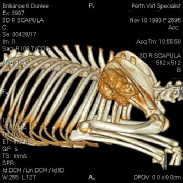
Copyright © 2013 CanineCancer.org.au All rights reserved.
Osteosarcoma is the most common bone tumour of dogs. It originates in the cells that make the bone. It accounts for around 85% of tumours in the canine skeleton. It is most common in the front legs, especially in the area above the foot, but can also occur in the hind legs. It is most active at either end of a bone rather than the middle. When osteosarcoma occurs in the limbs it is known as appendicular osteosarcoma. It can also occur in the bone of the skull, spine and nasal cavity which is the axial skeleton
Breeds such as the Rottweiller, Great Dane and Irish Wolfhound have a higher incidence of the disease. Symptoms to look out for are lameness, especially on a large breed dog, that does not resolve itself quickly. A swelling or mass can also show in the affected area and you should see your veterinarian for immediate testing. Middle aged to older dogs seem to be more susceptible to these tumours.
Osteosarcoma almost always spreads elsewhere in the body – called metastasis. Osteosarcoma can spread to other bones; in these bones it is more common in the middle of the bone rather than at the ends of the bone. Secondary tumours are often found in the chest and chemotherapy is the best treatment for this. Xrays of the chest are useful to detect the cancer’s spread. A fine needle biopsy taken from any enlarged nodes is another test that can be conducted to help determine the extent of the spread, though lymph node spread is less common than through the blood. Note that when the initial lump is first noticed, xrays will show it to be in the lungs in only 10%, but almost every dog (98%) will have it there too small to see. The purpose of the xrays is that if the cancer is advanced, the dog often should not go to surgery.
When osteosarcoma is suspected in the limbs, xrays of the affected limb will be taken. Other tests as recommended by your oncologist should also be undertaken. The standard choice of treatment is amputation of the limb. Sometimes due to other reasons amputation might not be possible. The dog may have arthritis, or be too old to undertake major surgery. Chemotherapy should follow surgery to treat any spread that may not yet be apparent. The combination of surgery and chemotherapy is the most effective treatment. Radiation and/or chemotherapy are effective palliative treatments when surgery isn’t possible, improving quality of life for up to a year.
The average survival rate for dogs with osteosarcoma in the limbs who are treated with surgery and chemotherapy is a year – so half the dogs are still happy into their second year and a quarter into their third. Around one in 6 dogs has very long survival (4-
Quality of life needs to be maintained. Your oncologist will be able to provide you with a treatment plan best suited to your dog so this can be attained.
**Accuracy checked 18 September 2013,
Dr Ken Wyatt BSc BVMS FANZCVS,
Registered Specialist in Veterinary Oncology,
Perth Veterinary Oncology

A CT Scan showing a Scapula Osteosarcoma


Other reliable and more detailed information on Osteosarcoma











